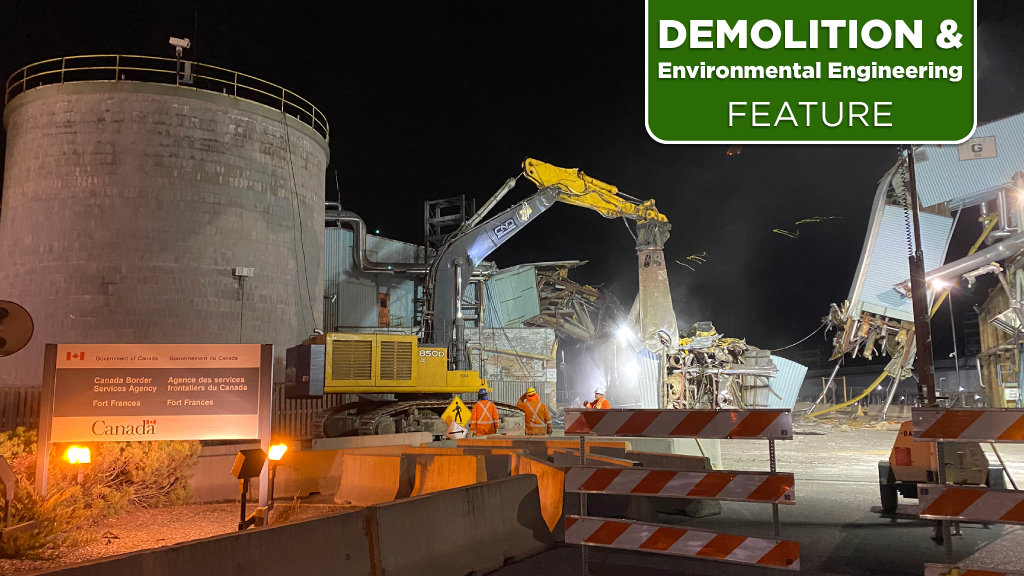It’s not a request that Canadian National Demolition (CND) takes lightly, but the safe demolition of part of the former Resolute Forest Products pulp and paper mill in Fort Frances, Ont. required a full overnight closure of the international border crossing between that town and International Falls, Minn.
The mill was built in 1912, as was the original private international road and rail bridge, owned by the Minnesota and Ontario Paper Company. The bridge, which remains the only connection between the two communities, is still jointly owned by Resolute Forest Products on the Canadian side and Boise Cascade, which continues to operate a pulp and paper mill in International Falls.
The Fort Frances mill was closed in 2014 and its assets were sold to a numbered company under Riversedge Development in 2019.
The four-phase demolition contract was awarded to CND of Uxbridge, Ont., which began work on Nov. 1, 2020. The company is assigning 25 workers to the project and about a dozen excavators, including high-reach models, all equipped with heavy shears.
The contract includes hazardous materials abatement, engineering, materials processing and shipping of scrap and encompasses more than a million square feet of buildings, three paper machines, a kraft mill (used to convert wood to pulp), a biomass plant and a co-generation plant. The tallest structure is a 65-metre stack associated with a recovery boiler.
The most complex part of the demolition, however, involved an inauspicious overhead gallery that crosses the international bridge on the Canadian side. The gallery contains piping once used to transport steam, gas, water and pulp between the two mills.
“The planning that goes into closing an international border is beyond anything most people can imagine,” says CND president, Jeff Norton.
“It required us to negotiate with the Canada Border Services Agency (CBSA), U.S. Customs and the Minnesota Department of Transport for starters. But we also had to negotiate with the hospitals and the paper mill in International Falls to ensure they could still continue to rely on essential Canadian workers who needed to make shift changes.”
Norton analyzed traffic counts supplied by the CBSA to determine when a border closure would involve the least disruption. He also worked with local trucking companies on both sides of the border to ensure that critical supplies were not delayed and that transports weren’t lined up at the border during closure.
Ultimately, all parties agreed that a closure lasting from 8 p.m. on Saturday, March 20 to 4 a.m. on Sunday, March 21 would cause the least disruption.
“Ensuring we could complete the demolition of that gallery in an eight-hour timeline required a lot of pre-work,” says Norton.
“We were working from original drawings that date back to 1924. The configuration of the gallery and piping was so tight that we needed to send in workers to hand cut a lot of the structure. With pre-engineering and air gapping we could ensure that the gallery would still be standing prior to the border closure but come down as quickly as possible once it closed. We performed our final pre-cut literally at the moment of border closure.”
The unexpected arrival of gusts of wind of up to 90-kilometres per hour over the falls added to the challenges of removing the gallery under tight timelines. High-reach excavators easily tore through most of the century-old structure, but parts of it remained surprisingly resilient.
“Even with the pre-cuts, removal of the gallery required the full eight hours to complete,” says Norton. “By 4 a.m., we had it neatly stacked on another part of the property, waiting for recycling. Cars and trucks started to cross the bridge a few minutes later.”
Norton estimates that the demolition project will be substantially completed before the end of 2021, leaving the property ready for redevelopment.





Recent Comments
comments for this post are closed